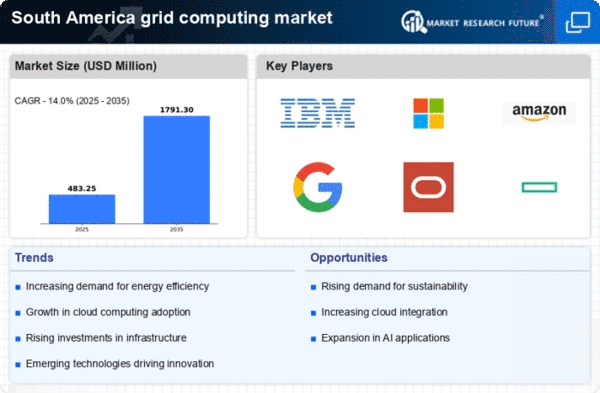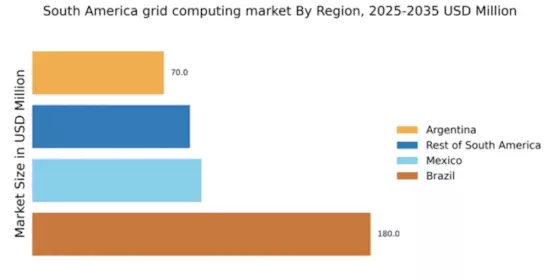Rising Energy Costs
The escalating energy costs in South America are driving organizations to seek more efficient computing solutions, thereby benefiting the grid computing market. As energy prices continue to rise, businesses are increasingly aware of the need to optimize their energy consumption. Grid computing offers a viable solution by enabling the sharing of resources across multiple systems, which can lead to reduced energy usage and lower operational costs. In 2025, energy costs are projected to increase by approximately 15% compared to previous years, prompting companies to adopt grid computing technologies that can help mitigate these expenses. This trend is particularly relevant for industries with high computational demands, such as finance and research, where energy efficiency is paramount. Thus, the grid computing market stands to gain traction as organizations prioritize sustainable practices and seek to minimize their energy footprint.
Growing Need for Scalability
The increasing need for scalability in IT infrastructure is a significant driver for the grid computing market in South America. As businesses expand, they require flexible computing resources that can adapt to changing demands. Grid computing provides a scalable solution by allowing organizations to tap into a network of distributed resources, enabling them to handle varying workloads efficiently. In 2025, it is estimated that around 60% of South American companies will prioritize scalable IT solutions to support their growth strategies. This trend is particularly evident in sectors such as e-commerce and telecommunications, where rapid growth necessitates robust computing capabilities. Consequently, the grid computing market is likely to experience heightened interest as organizations recognize the advantages of scalable solutions in maintaining competitiveness and operational efficiency.
Increased Internet Penetration
The rising internet penetration in South America is a crucial driver for the grid computing market. As of 2025, internet access has reached approximately 75% of the population, facilitating greater connectivity and data exchange. This increased access enables businesses and institutions to leverage grid computing solutions for enhanced data processing and resource sharing. The growing number of internet users, particularly in urban areas, is likely to stimulate demand for grid computing services, as organizations seek to optimize their operations and improve efficiency. Furthermore, the expansion of mobile internet services is expected to contribute to this trend, allowing remote access to grid computing resources. Consequently, the grid computing market is poised to benefit from this surge in internet connectivity, as more entities recognize the potential of distributed computing to address their computational needs.
Emergence of Big Data Analytics
The emergence of big data analytics is significantly influencing the grid computing market in South America. As organizations increasingly rely on data-driven decision-making, the demand for advanced analytics capabilities is surging. Grid computing offers the necessary infrastructure to process and analyze large datasets efficiently, making it an attractive option for businesses looking to harness the power of big data. In 2025, it is projected that the big data analytics market in South America will grow by approximately 25%, further driving the need for grid computing solutions. Industries such as healthcare, finance, and retail are particularly focused on leveraging big data to gain insights and improve operational performance. Therefore, the grid computing market is well-positioned to capitalize on this trend, as organizations seek to integrate powerful analytics capabilities into their operations.
Focus on Collaborative Research Initiatives
The focus on collaborative research initiatives in South America is emerging as a key driver for the grid computing market. Research institutions and universities are increasingly engaging in collaborative projects that require substantial computational resources. Grid computing facilitates this collaboration by providing a shared infrastructure that enables researchers to access and utilize distributed computing power. In 2025, it is anticipated that funding for collaborative research projects will increase by around 20%, further enhancing the demand for grid computing solutions. This trend is particularly relevant in fields such as environmental science and biotechnology, where large-scale data analysis is essential. As a result, the grid computing market is likely to benefit from the growing emphasis on collaborative research, as institutions seek to enhance their capabilities and drive innovation.


















Leave a Comment